My go-to best practices include using catchy subject lines, personalizing content, and prioritizing mobile. Review strategies for restaurant email marketing.
Restaurant email marketing is one of the most effective ways to connect with and grow your customer base. The best email marketing strategies maximize content, engage customers, and build a community around your business’s brand.
My go-to best practices include using catchy subject lines, personalizing content, and prioritizing mobile design. Additionally, it’s essential to know how to successfully engage in email marketing, grow your mailing list, and create valuable content for your customers.
Let’s discuss the best email marketing strategies, ideas, examples, and best practices for your restaurant. Plus, I’ll give you my recommendation for the best platforms to help you streamline the email process.
Email marketing allows restaurants to maintain long-term relationships with local, repeat customers.The easiest ways to build an email list are to collect email addresses at checkout online and in person — just make sure you get the customer’s consent.I recommend that every restaurant start with welcome emails, promotional or event emails, and review request emails.Between 50% and 60% of people access their emails through their phones, making mobile design an absolute must for effective communications. Tracking key metrics — open rates, CTRs, and conversion rates — is crucial for long-term email success.
Email marketing for restaurants is unique due to the relationship they have with their customers. Restaurants sell experiences, not products, and require customers to dine in or return frequently over time.
This customer behavior offers the opportunity for a longer-term relationship between the business and the customer, which is why email marketing is so useful. Email lists for restaurants can be used to keep the business-customer relationship exciting and help attract local and repeat customers.
Email lists do well with restaurants because restaurants are often hyper-local businesses. So, the emails you send customers are highly relevant to their local communities and help connect them with the region in which your restaurant operates.
Restaurant promotions alone are often seasonal, have smaller windows, or are tied to special events. But email marketing can communicate seasonal menu rotations and events in an agile and engaging way. Where other businesses use email marketing to sell products, restaurants can use it to invite guests in for truly memorable and special experiences.
Knowing how to build an email marketing list is just as important as the emails you send to its members. You can build your restaurant’s email list in various ways, and most strategies are easy to implement. Below are some of the best tactics I use to build restaurant email lists.
There are various types of emails you can send to your mailing list. Restaurants are positioned uniquely due to the experiential services they provide. That being said, there are various email types your restaurant can send out to engage with your customer base and generate excitement for new items. Below are some email types you can send to engage better and grow your mailing list.
Welcome emails are the emails customers receive when they first sign up for your mailing list. It’s essential to have an automated welcome email set up, as it creates a sense of inclusivity and engagement for the reader. A welcome email can include a thank you for signing up, a brief introduction to your restaurant’s philosophy, and even a small reward for being on the mailing list.
You can also use the welcome email to set expectations for the types of messages customers can expect, as well as an event calendar for important dates. I suggest sending this email after the customer joins the list or books a reservation online for the first time (just be sure to make it clear that booking online adds the customer to the mailing list).
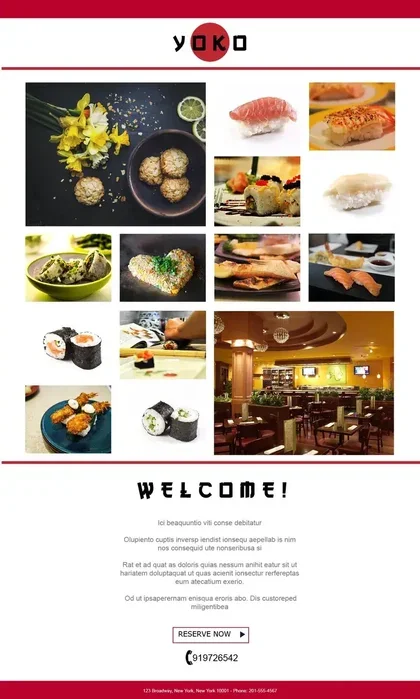
The point of an email list is to drive repeat visits and get customers to bring others into your restaurant. These objectives make promotional or discount emails one of the most important types of emails you can send to customers.
Limited-time offers (LTOs), exclusive discounts, and even rotating weekly menu newsletters can encourage customers to return, incentivize them to open your messages, and increase restaurant sales. These promotional emails work best when a value is offered or exclusivity is directly tied to the email.
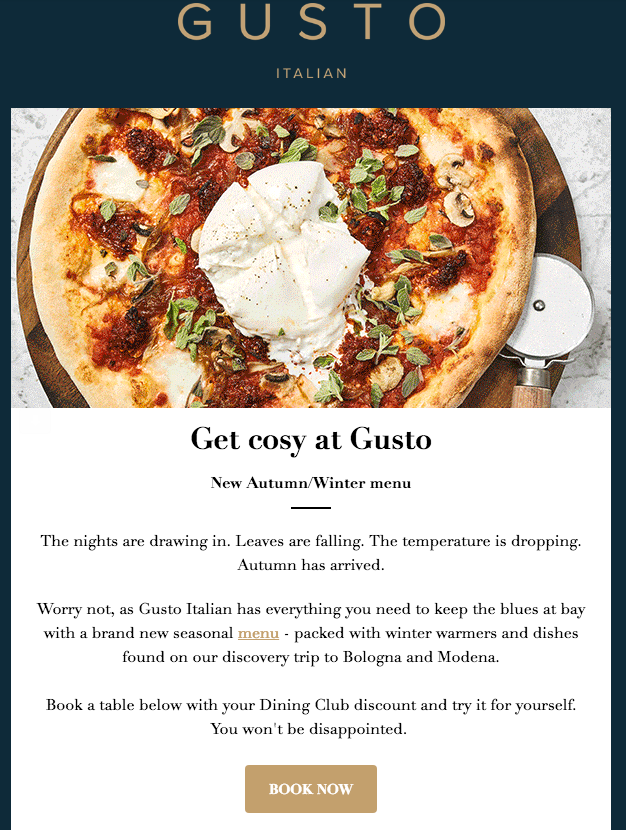
Hosted events can be a great revenue driver for restaurants and lead to meaningful community exposure. Event announcement emails are often the best way to get the word out, because they can contain links that make it easy for customers to RSVP.
These emails should include the name or theme of the event, the date and time, pricing, and any key highlights of the event itself. For optimal success, I recommend sending these emails two to three weeks before the event. These emails are also great for sharing holiday deals or events.
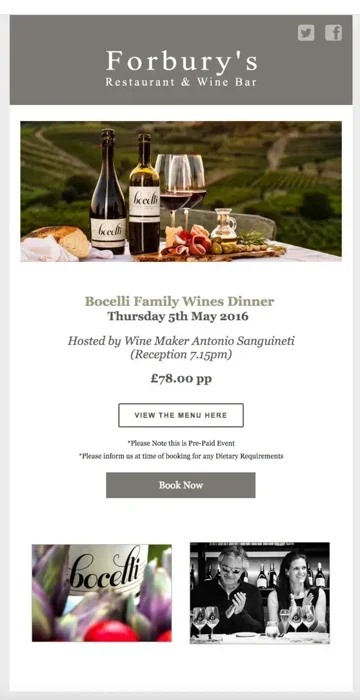
This type of email is where you build value for your mailing list. These emails aim to deepen loyalty to your restaurant’s brand and the emails you’re sending. Loyalty emails often contain exclusive deals for list members only, early access to private events, and progress updates on order- or visit-based rewards programs. Personalizing these emails as much as possible is essential for the best results.
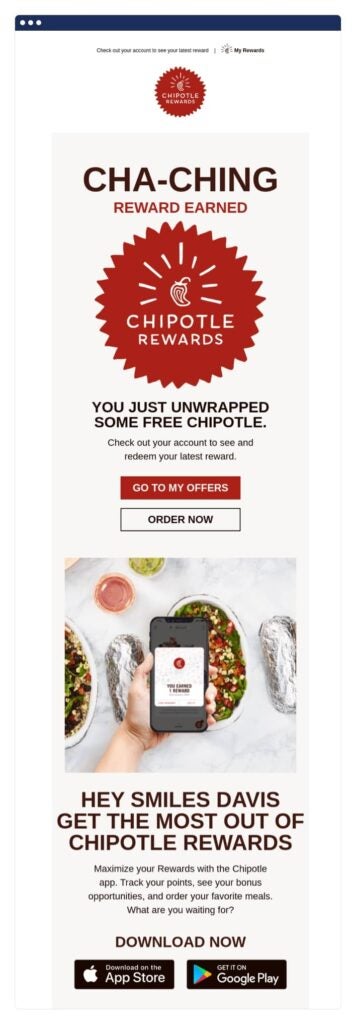
The last type of email I recommend sending is one that leads to customer reviews. The best of these emails thank a customer for dining in and offer a link to where the customer can review their experience.
This method is one of the best ways to follow up with customers, get feedback, and generate reviews for your Google Business or Yelp profiles. I recommend sending these within 48 hours of a customer’s visit or purchase.
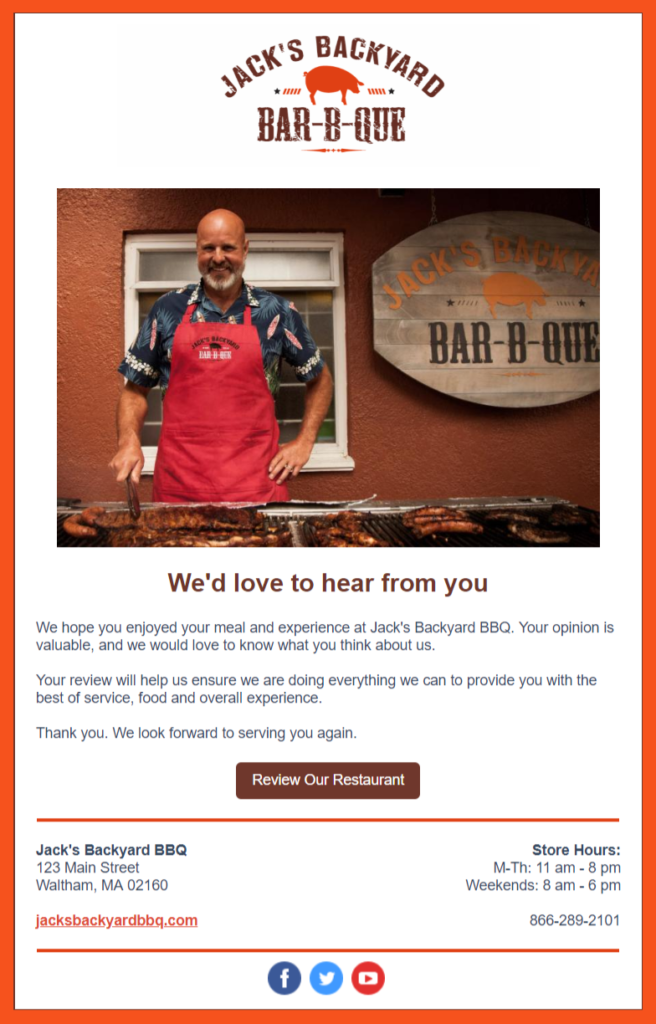
You should follow key practices when executing an email marketing strategy for a restaurant. What may work for other industries may not for restaurants due to the intimate nature of serving food to others.
However, restaurants are positioned uniquely to maximize customer relationships and repeat business. Below are some best practices I follow when deploying a restaurant email marketing strategy.
Subject lines are the bread and butter of email marketing success. They set the tone, spark curiosity, and influence the overall value perception a customer has before opening the email. I highly recommend A/B testing in the early stages of your email marketing strategy to determine the best subject line style for your restaurant. Exciting, engaging, and focused subject lines can be the difference between low and high open rates.
Customer preferences are crucial in email marketing, and restaurants can easily identify these preferences. That being said, making your emails more personable by using a customer’s name, celebrating a birthday, or sharing discounts or other offers based on experience will always drive engagement. The more personalized your email marketing strategy is for each customer, the higher the rate they will engage with your emails.
Mobile optimization is vital for your email marketing to succeed, and most modern email marketing platforms can help. It is assumed that 50%-60% of all email marketing campaigns are opened on a mobile device, so considering that half of your audience may do this, mobile optimization should be a priority.
Mobile optimization usually means using single-column layouts, larger buttons for links, shorter subject lines, and placing your call to action near the top of the email body. I recommend sending yourself a mobile email to ensure it is well-optimized for your phone and adjusting what gets cut off or doesn’t fit.
Adding optimized visuals to an email marketing campaign is a great way to market new items or encourage customers to return to your restaurant. Smart utilization of food photography, GIFs, and consistent branding will make your emails appealing and fun to read.
Use mouthwatering images to break up larger bodies of text or showcase new menu offerings. I recommend building image templates so that it’s easier to swap photos and maintain a consistent look.
One of the perks of email marketing is that you can automate your emails, sending them to specific customer groups at different times. Most restaurants segment their mailing list into “new customers” and “returning customers.”
New customers have just signed up for the list or have not yet dined at your restaurant. These customers should be treated like VIPs and receive welcome emails and informational emails about your restaurant and menu. Returning customers should be treated like a community of insiders, receiving exclusive, first-look access to new menus, loyalty rewards, and occasional check-ins.
It’s important to know the best times to send restaurant marketing emails. The times you send an email will depend on the day, so experiment with the best times for your specific business. However, I recommend the following general communication times.
The final aspect of automation is setting up special personal event emails for birthdays, anniversaries, and other customer milestones. Birthdays can be collected during email sign-up and may offer a free menu item, a discounted tasting menu, or access to a key event.
Anniversary emails can offer items like free glasses of champagne or a complimentary shared dessert. I suggest sending these emails between five and seven days before the actual date so that customers can make plans to dine at your restaurant.
Optimizing your email performance is crucial for confirming that what you send out resonates and works for your target audience. So you should be aware of a few key metrics when tracking your email performance.
When it comes to optimizing your email marketing, A/B subject line testing is one of the most effective ways to refine your email marketing strategy. A/B testing involves sending two different versions of an email to see which one performs better.
In these tests (I recommend running more than one), try different subject lines, varied content, and various offers for your customers. This type of testing offers immediate feedback and is a great way to improve your email marketing and its performance. Just be sure that your A and B variations have easily identifiable differences.
For example, if you’re trying to see if a question works better than a statement, make sure the two subjects are nearly identical (i.e., “Who’s ready for the hot honey chicken sandwich?” vs “The hot honey chicken sandwich is here”). If your subjects are too different, it’ll be harder for you to discern what made one work better than the other.
Evolve tests further by experimenting with the type of question, for example. Closed-ended questions (e.g., “Can you handle the hot honey chicken sandwich?”) that elicit yes-no answers might instantly deter any reader who might say no. Open-ended questions (e.g., How do you like your hot honey chicken sandwich?”) elicit a more thoughtful response and curiosity for what’s in the message. But overall, what works best will come down to your audience’s preferences.
The best way to optimize your email marketing is to use analytics from your email campaigns, paired with A/B testing. I suggest using your analytics to look for patterns over time and recognize what works and what doesn’t for different segments of your mailing list. Rewarding engaged customers with offers, constantly fine-tuning, and always looking to change subject lines for better performance leads to the best success.
Finding the right email marketing software for your restaurant is important, as this software will be the tool you use to communicate with customers outside your restaurant. There are many great options on the market, but the right choice for you depends on your restaurant’s needs and marketing campaign’s ambitions. Review some of the best email marketing software for restaurants available in 2025.
| Best for | Starting monthly price | Personalization tools | |
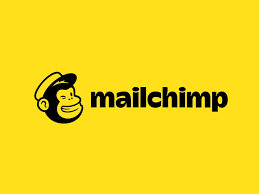 Mailchimp Mailchimp | Best for beginners | $20 (up to 500 contacts) | Robust |
| Visit Mailchimp | |||
 Squarespace Squarespace | Best for growing your email list | $16/mo for a website with list & subscriber tools | Limited |
| Visit Squarespace Use code RHQ10 for 10% off! | |||
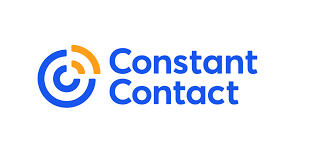 ConstantContact ConstantContact | Best for restaurant loyalty | $12 (0-500 contacts) | Good |
| Visit Constant Contact | |||
 Square Square | Best for POS integration | $15 (up to 500 contacts) | Good |
| Visit Square | |||
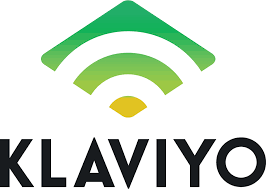 Klaviyo Klaviyo | Best for advanced segmentation | $20 (251-500 contacts) | Robust |
| Visit Klaviyo | |||
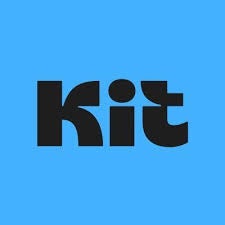 KitKit KitKit | Best for small restaurant owners | $25 (up to 1,000 contacts)* | Limited |
| Visit Kit | |||
*Billed annually
Mailchimp is a great email marketing software for users new to email marketing. Mailchimp offers a free trial and has a variety of pre-built templates for its users. Signing up for the free plan gets you access to up to 1,000 email sends per month, which can be great for getting your email marketing strategy off the ground.
Mailchimp offers automated emails, mobile optimization, A/B testing, landing pages, and sign-up forms. They also allow you to segment your audience for the best strategic deployment of your email marketing.
Constant Contact is your best bet when trying to build loyalty through your email marketing campaigns. The software has built-in loyalty campaigns, such as a “visit 5 times, get a free appetizer” offer.
They offer pre-built loyalty and rewards templates, automated emails for loyalty progression, and mobile-optimized emails to ensure customers always have access to key loyalty information. They can integrate with POS systems, such as Toast, to sync loyalty data automatically.
Square for Restaurants offers its email marketing software through Square Marketing. The size of your mailing list determines the price of this built-in marketing software, which works directly within the Square ecosystem.
The software uses your POS data to segment customers, automates campaigns based on sales triggers, and can even track sales against marketing conversions. Another neat tool is that Square can generate discount codes that are directly applied to your POS to save you time.
Klaviyo is known for its deep behavioral segmentation capabilities. For example, it can build segments for customers who have spent $200 in the last three months, customers who only visit for lunch, or even those who have opened promotional emails but haven’t redeemed offers.
Klaviyo can utilize multichannel targeting, such as email and SMS, to effectively leverage your contact list in a meaningful way. The personalization tools with Klaviyo are pretty incredible, and the software integrates with most major POS systems for an efficient and seamless experience.
Kit is a great email marketing software for small restaurant owners. I have personally used ConvertKit to publish newsletters, and it offers just enough tools to be proficient for a small to medium-sized mailing list.
Kit’s setup is very simple, and the tools it provides make launching your restaurant email marketing campaign easy and quick. Due to its mobile-friendly design, Kit offers strong deliverability and is great for smaller restaurants that want to establish email marketing practices.
Email marketing is one of the most underutilized tools in restaurant marketing. Email lists can be valuable for growing a customer base or driving foot traffic during key service times.
Furthermore, email marketing helps you build a community around your restaurant and personalize hospitality when guests aren’t in the building. Below are some of the most frequently asked questions about email marketing for restaurants.
Yes, email marketing is highly effective for customer engagement and growth. Email marketing strategies can build customer loyalty and create a sense of community around your restaurant. Use your email lists to connect with your regulars and treat them like VIPs.
Furthermore, your restaurant can highlight promotions, control who receives emails and when, and even personalize messages for different customer segments based on their likes and behavior.
The best email marketing strategies for restaurants revolve around building a strong list, sending engaging content, and being thoughtful about your target audience when sending emails.
Great restaurant email marketing creates urgency for specific events or limited items, fosters a sense of community within your restaurant’s brand or identity, and dictates a clear call to action for customers.
It really depends on the goals of your email marketing campaign, but a minimum for email marketing is once a month. The ideal pace for email marketing campaigns is up to two times a month.
However, if your menu changes or your restaurant has many events, once a week is best. Your emails need to be valuable to the reader, so managing your pace against the quality of your message is important for keeping customers and growing your mailing list.
The 80/20 rule is an email marketing guideline centered on the concept of value to the reader. According to this rule, 80% of your emails should be of value to your readers, and 20% should be promotional.
For example, educational or storytelling content is often great for restaurant customers, while exclusive reservations, special offers, and special events would be considered promotional. Following this rule helps bolster your email presence as valuable and respectful of your customers’ time. And it’s a great way to grow your mailing list organically.
Email marketing for restaurants is one of the most effective ways to engage with your customer base. The ability to personalize customer emails through software like Mailchimp makes it easy to ensure overall customer satisfaction and retention.
Consistent testing and improvement, as well as retaining customer feedback, are the best ways to ensure your email marketing campaigns provide value and return the investment of your time. Use the tools in this article to better understand the best ways to market your business through email.
Ray Delucci is a graduate of The Culinary Institute of America with a Bachelor’s in Food Business Management. He has experience managing restaurants in New York City, Houston, and Chicago. He is also the host of the Line Cook Thoughts Podcast, where he interviews and shares the stories of foodservice workers. Ray currently works in food manufacturing and food product development.
Property of TechnologyAdvice. © 2025 TechnologyAdvice. All Rights Reserved
Advertiser Disclosure: Some of the products that appear on this site are from companies from which TechnologyAdvice receives compensation. This compensation may impact how and where products appear on this site including, for example, the order in which they appear. TechnologyAdvice does not include all companies or all types of products available in the marketplace.